Table of Contents
What will happen to data storage if it is no longer centralized? With the constantly increasing speed of technological development, managing and processing information is completely altered. At its core is a blockchain database that completely overhauls how data is handled by putting transparency, immutability, and decentralization into the foreground over the centralized, inflexible models of past systems.
In this comprehensive handbook, you will discover what differentiates this new approach, examine its key benefits and drawbacks, and explore real-world applications. As a developer, entrepreneur, or just someone curious about the latest technology, this handbook will show you why decentralized data storage is rapidly becoming the new gold standard.
What Is a Blockchain Database?
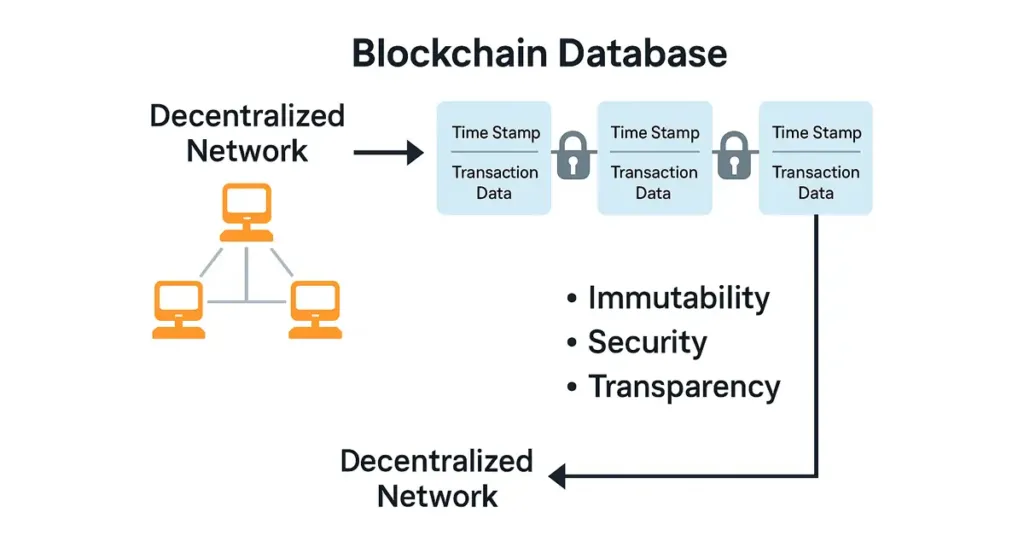
Information on a decentralized network gets recorded through an electronic billing system known as the blockchain database instead of a traditional centralized server system. Time stamps, transaction information, and cryptographic hashes bind the blocks of data together. This construction has the effect that data, once it’s added, is practically impossible to modify, which enhances security as well as transparency. Its immutability and decentralization make it particularly valuable to use in environments where tamper-proof, consistent recordkeeping is required.
How AI and Decentralized Systems Share a Data-First Philosophy
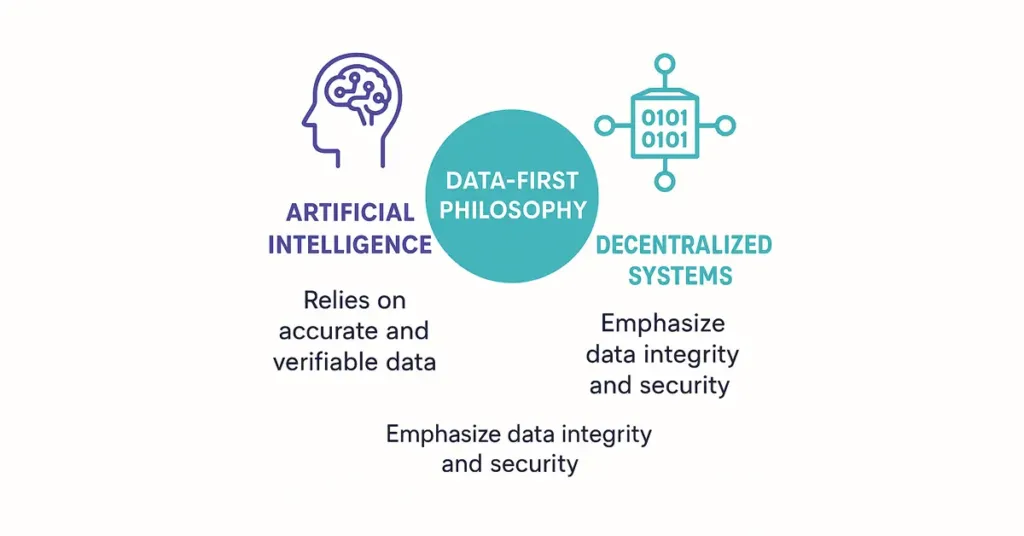
The technology classified as artificial intelligence (AI) exists as a revolutionary system that has recently started penetrating multiple industrial sectors over recent years. The ability of data analysis and intelligent decision-making has been growing continuously since the inception of AI in the 1950s. AI functions properly based on the precise and reliable data being supplied to it. AI system quality increases in direct proportion to the level of data verifiability, together with data consistency and accuracy.
Similar to AI, decentralized systems also value data integrity and security. In decentralized applications (dApps), which are primarily blockchain-based, the data is inviolable and open, providing a good platform for AI systems to base their decisions on. If AI systems are given quality, genuine data, such as data stored in decentralized networks, their decision-making capacity is enhanced, and they are more accurate and efficient.
This data-first methodology aligns decentralized systems and AI with their quest for trustworthiness and transparency. All information added to blockchain-based systems remains unalterable through the process since changes or edits cannot be made to blockchain-written data. This makes AI algorithms provide stable, reliable data, precluding the likelihood of errors or bias caused by corrupted or tampered data.
By introducing the secure and decentralized nature of blockchain, AI will have better-informed decisions with fewer susceptibilities to data modifications. Harmonization of such technologies, particularly in such domains as finance, health care, and supply chain management, is most beneficial where openness and data integrity are key. Through converging, the two technologies pursue better secure, streamlined, and trustworthy solutions, focusing on data for decision-making.
Why Choose a Blockchain Database?
1. Immutability
The second most important property is immutability. After the information has been written, there is no possibility of changing or deleting it except through a consensus of the whole network. Data records are safeguarded as complete and tamper-free while maintaining authenticity through this system. In life-critical applications like finance, supply chain, and healthcare, where data integrity is of utmost concern, this property brings immense credibility and transparency.
2. Decentralization
In contrast to classical systems based on a centralized power foundation, distributed networks work with a peer-to-peer, distributed topology. This allows them to bypass single points of failure, increase system resilience, and preserve uninterrupted functioning even if certain nodes fail. It also empowers the participants through decentralization, permitting greater transparency and fairness.
3. Transparency and Auditability
Every update in distributed ledger systems includes timestamp data that becomes visible to approved participants through system access. It provides an indelible, open record of events that cannot be altered once finalized. For enforcement of regulation, audits of finance, or guarantee of authenticity, such transparency makes incredibly high levels of accountability possible.
4. Improved Security
The necessary cryptography includes hashing along with digital signatures for data protection within decentralized systems. The processes possess strong resistance to illegal record changes and data observation, especially better than traditional data management systems do.
5. Integration of Smart Contracts
Smart contracts run business rules and workflow by taking actions as per pre-defined rules whenever specific conditions are met. This reduces the need for human interaction, minimizes human errors, and enables secure, optimized processes in any sector.
How a Blockchain Database Works

The internal operations of a blockchain database include a few layers of cryptographic protocols and consensus systems. A simplified overview is provided below-
1. Data Entry
Data is entered into a blockchain as transactions. Transactions are anything from financial transactions to recorded events or validated information. Validation of transactions leads to their organization into blocks known as an arrangement. Gathering transactions in this manner makes the information stored in a space-saving way while maintaining it whole.
2. Hashing
Every block of information is hashed cryptographically. The conversion of data in the block through hashing results in a fixed-length character string. Each hash function serves as a distinctive identifier that distinguishes one block from another. The hash would vary in response to any little alteration in the block’s data, warning us of potential manipulation. The hash guarantees each block’s integrity.
3. Chain Linking
Hashing blocks enables linking with the previous block, so they join the chain. The hash from the preceding block serves as the linking mechanism between blocks because it resides in the new block header. The linking process creates dependencies between all blocks, so any modification within a single block becomes challenging since it impacts all remaining blocks.
4. Consensus
New blocks require validator and network miner verification to gain blockchain authenticity before addition takes place. Proof of Work and Proof of Stake are consensus methods that let the blockchain system achieve mutual agreement. The algorithms guarantee that only valid, confirmed blocks are appended to the chain, and therefore, trust within the network.
5. Replication
All network nodes receive a copy of the updated block after everyone agrees. Replicating in a distributed fashion guarantees every participant has an exact copy of the blockchain to avoid data loss and complete openness.
Key Use Cases of a Blockchain Database
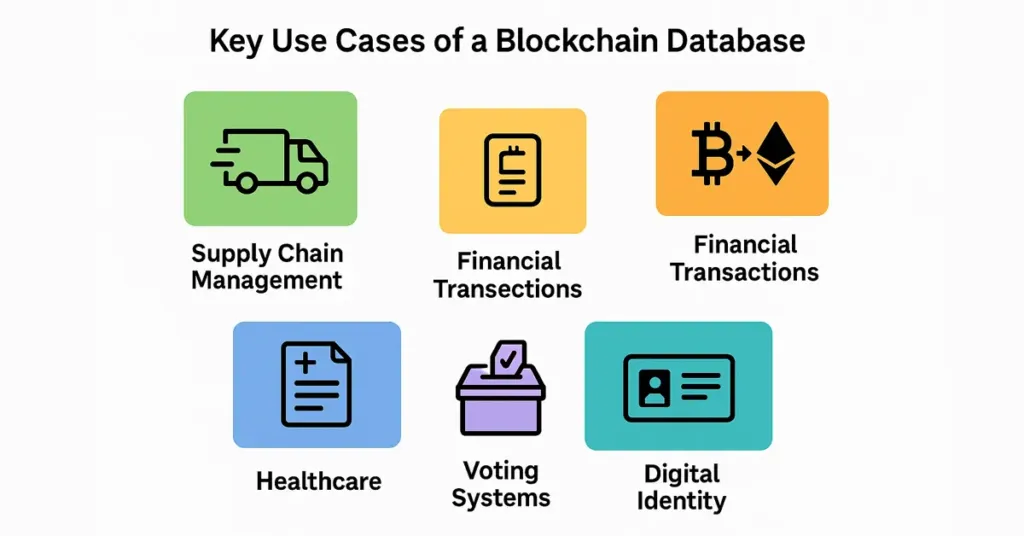
Supply Chain Management
Emerging technology is revolutionizing supply chain management with unprecedented transparency and trust. With a decentralized and unalterable infrastructure, digital ledgers today can trace products from origin through to delivery. Every step—production, storage, shipping, and delivery—is stamped on an unalterable, secure network.
Everyone can see the flow of products and the ability to check in real time. As a result, there is far greater accountability across the supply chain, which reduces fraud and counterfeiting. Further, in defects or contamination-related recalls, a tamper-evident and trustworthy record provides for a more rapid and effective response.
Financial Transactions
Decentralized technological systems, including Bitcoin and Ethereum, lead to financial disruptions by transforming fund flow and control systems in the payment system. People use digital currency to send payments amongst themselves through systems that do not require any middlemen PayPal-type services.
The system provides lower transaction fees, together with increased clarity, and speeds up payment processing. The decentralized finance movement has developed secure alternative solutions for typical financial services using decentralized technology.
Healthcare
Medical organizations value privacy, together with data security. Medical organizations can depend on decentralized technology to handle the secure distribution of sensitive patient information, including history, observing lab outcomes, as well as prescribing medications safely.
Data protection features working together with unalterable structures create an encryption system that blocks unauthorized access to records. This way, medical staff are always presented with the latest and correct details regarding their patients, which serves as a lifeline to diagnosis and treatment.
Voting Systems
The backbone of democracy is voting, and the integrity of voting should be maintained. A decentralized ledger system can establish trust and transparency in electronic voting by authenticating the voters and voters’ ballots in a tamper-proof environment. The vote is then securely stored and is not changeable once cast.
This prevents any vote tampering or external tampering. Public trust in the electoral process, as well as credibility and fairness to the election, also increases with the transparency of the system through independent auditing.
Digital Identity
Identity validation is another domain that is undergoing a revolution courtesy of decentralized systems. People can now control their Web personas in an open, user-managed format. Rather than trusting central administrations or managing disparate credentials, consumers can keep individuals’ information archived in a way that provides access only when particularly authorized.
This reduces the possibility of identity theft, reduces the loss of passwords, and enhances the general integrity of online content. Whether it is accessing healthcare, banking, or government websites, this streamlined process is an advantage and a protection.
Traditional Database vs. Blockchain Database
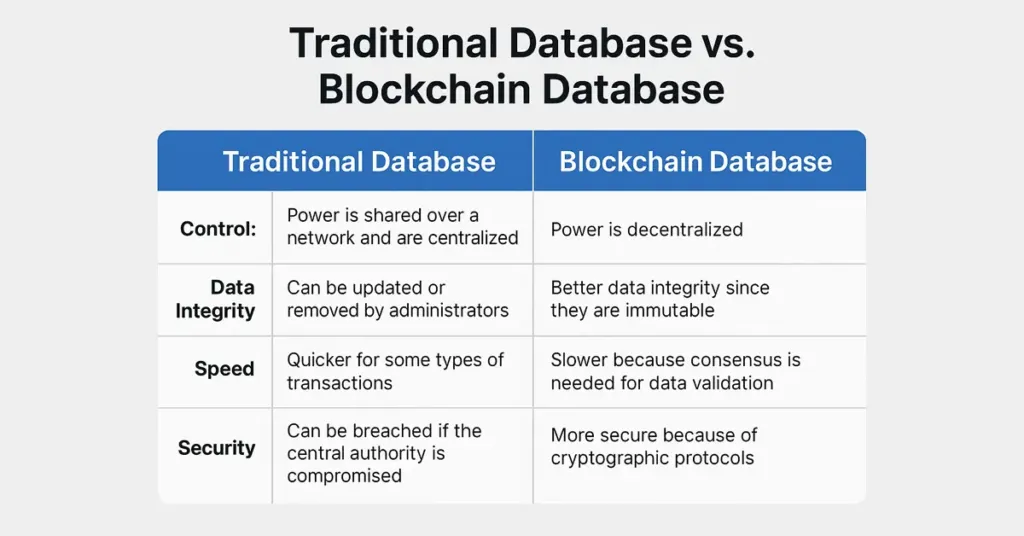
Key Differences-
- Control: Traditional databases share power over a network and are centralized, while blockchain databases are decentralized.
- Data Integrity: Blockchain databases have better data integrity since they are immutable, whereas traditional databases can be updated or removed by administrators.
- Speed: Traditional databases are quicker for some types of transactions because consensus is not needed for data validation.
- Security: Blockchain databases are more secure because of cryptographic protocols, while regular databases can be breached if the central authority is compromised.
The choice between a blockchain database and a conventional database would depend on the particular requirements of an application or company. Where real-time transactions and centralized control are needed, a conventional database is usually the way to go. But for applications where secure, transparent, and tamper-resistant management of data is necessary, a blockchain database offers unparalleled benefits.
Challenges and Limitations of a Blockchain Database
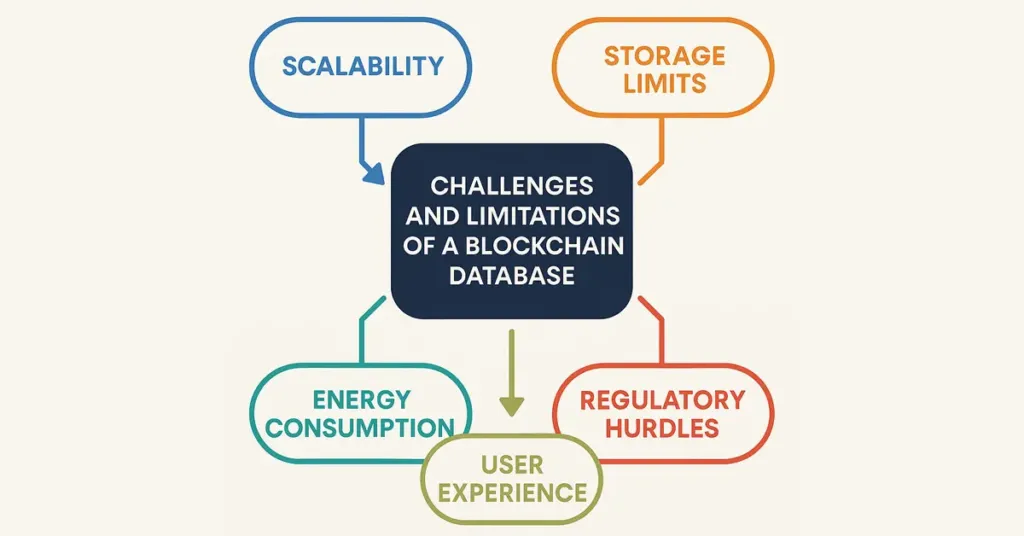
The challenges and limitations of a blockchain database are-
Scalability
Scalability is the most significant issue that a blockchain database must deal with. Each time new members are added to the network, volume and data, along with transactional volume, are increased. Conventional blockchain technology, particularly one based on Proof of Work (PoW), has no scale to cope with large-sized transactions. With each node required to check transactions and store a complete copy of the blockchain, the system may become sluggish and cumbersome, causing processing delays. This is especially a serious problem for those applications that have real-time data or high-frequency transactions.
Storage Limits
Blockchain databases are famous for being decentralized, but they were never intended to store large files like videos, images, or large documents. It costs too much and is too inefficient to maintain such data on the blockchain directly because of the storage needs of having to store a copy of the data on each node.
The more data there is on the blockchain, the more costly it is for participants to hold the whole ledger, particularly if it holds a lot of useless data. Due to this, most apps opt to save big files off-chain while using the blockchain to hold references or cryptographic hashes that verify data integrity.
Energy Consumption
The energy usage of blockchain platforms proves to be a significant problem, particularly when running algorithms like Proof of Work (PoW) as part of their consensus operations. The validation process, combined with transaction appending through blockchain, consumes extensive processing resources that raise energy usage levels.
This can have an environmental cost, especially with mass-scale deployments that require ongoing transaction verification. Although newer consensus algorithms such as Proof of Stake (PoS) are designed to circumvent these issues by minimizing the demand for computational resources, energy efficiency is still a problem for some blockchain implementations.
Regulatory Hurdles
Mass adoption of decentralized ledger technology encounters major barriers from legal and regulatory frameworks. The essential characteristic of permanent ledger systems creates conflicts with GDPR as well as other privacy protection laws. Under this law, individuals possess the right to request their data to be removed from computer systems.
Since distributed ledger entries are intended to be permanent and unalterable, however, deleting or amending stored data is technically challenging. This presents possible compliance challenges and questions about how these technologies are going to fit with privacy legislation.
User Experience
Aside from the compelling benefits of blockchain technology, the user experience represents a major stumbling block to adoption at scale. The technical finesse of working with a blockchain database—i.e., managing wallets, authenticating transactions, and verifying digital signatures—represents a deterrent to non-technical users.
User interfaces and experiences are likely to need a lot of development to get blockchain applications mainstreamed. With time, there will be some effort to ease and simplify onboarding and have user-friendly interfaces to convert the masses.
FAQs
What is the main purpose of a blockchain database?
A blockchain database serves as the primary architecture to store network-based information through a protected, transparent method that remains verified and unalterable. The system delivers and authenticates data immunity from changes or removal, thereby creating further confidence and responsibility as well as protection for the system. Applications that need tamper-evident, authentic data management should employ decentralized blockchain databases as their primary data solution.
In what way is a blockchain database distinct from a standard database?
The blockchain database distributes composed blocks of information across numerous nodes for decentralized operations, which cannot be modified. After block appendage, each block becomes resistant to modification because it uses cryptographic security measures. A regular database runs on a centralized server and includes CRUD (Create, Read, Update, Delete) operations enabling authorized users to make changes but this functionality makes it a target for security breaches.
Is it possible to hack a blockchain database?
Despite being impossible to ensure full hacking protection in any system, a blockchain database stands strong because of its decentralized nature, coupled with advanced cryptographic algorithms. The integrity of blockchain data is protected through two conditions: attackers must simultaneously modify all network node blockchain copies, which proves impossible, thus making blockchain databases more secure than standard systems.
What are some popular blockchain database platforms?
The blockchain database market features four popular platforms, which include Ethereum as well as Hyperledger Fabric, together with Corda and BigchainDB. Users can access a range of different features through these blockchain database platforms, which include decentralization measures as well as scalability capabilities and smart contract support. Ethereum leads deployment for decentralized applications, but business operations mostly use Hyperledger Fabric as their blockchain platform.
Is data in a blockchain database private?
Privacy in a blockchain database is based on the type of blockchain employed. Public blockchains, such as Ethereum, are open, where everyone shares all the entries in the data. Private or permissioned blockchain frameworks are limited to providing access only to the authorized stakeholders who might view or even modify the information with higher privacy.
Which sectors will gain the most from a blockchain database?
A blockchain database provides maximum utility to industries consisting of finance, health, logistics, property management, and identity systems because of its secure yet transparent decentralized database solution. Using blockchain technology enables these sectors to strengthen data protection while fighting fraud and enable better tracking, and automate work procedures as well as establish trustworthy systems for managing transactions.
How do smart contracts work with a blockchain database?
Smart contracts are programs on computers sealed in a blockchain database. The contracts trigger pre-programmed actions automatically upon triggering conditions, and once triggered, the conditions will always be enforced without involving any intermediary. Using blockchain immutability in conjunction with transparency, smart contracts can enhance trust, reduce time consumption, and eliminate intermediaries in organizations.
Is it an environmentally sustainable blockchain database?
A blockchain database can be green, particularly by the application of energy-friendly consensus algorithms such as Proof of Stake (PoS). While the high-energy Proof of Work (PoW) approaches are different, PoS and alternative rival technologies consume much less power, thus increasing the sustainability of blockchain platforms.
Are pictures and videos like files stored in a blockchain database?
A blockchain database can technically contain big files in a technical sense, but the storage limitations and high costs make implementing this approach impractical. Most applications rather store big files off-chain and hold the cryptographic hashes thereof within the blockchain, which is used to verify the integrity and authenticity of the files.
What is a node in a blockchain database network?
The blockchain network depends on nodes, which are computers that serve to keep duplicate or full blockchain ledger information alongside verification capabilities. The network operates with integrity through nodes that authenticate and verify new transactions. They provide decentralization, security, and correctness of the blockchain system.
How do consensus algorithms work within a blockchain database?
Consensus algorithms in a blockchain database ensure all nodes agree on the ledger’s state, maintaining everything on track and safe on the network. Proof of Work (PoW), depending on computational work, Proof of Stake (PoS), which depends on tokenized validators staked, and Practical Byzantine Fault Tolerance (PBFT), providing fault tolerance with high-speed consensus, are some of the most widely used consensus mechanisms.
Are there any risks involved with having a blockchain database implemented?
Yes, there are risks involved with having a blockchain database implemented. Some of these are the scalability problem, where the platform is cumbersome to make numerous transactions rapidly; issues with compliance with the law, particularly in jurisdictions with stringent requirements for the law; and permanent incorrectness or data sensitivity, where data cannot easily be deleted or modified once it has been written to the blockchain.
Can private blockchain databases be implemented for businesses?
Yes. Businesses can create private blockchain database networks with bespoke features to meet their business processes. These platforms provide bespoke permissions, access controls, and increased privacy, which are perfect for keeping sensitive internal information while still enjoying the advantages of blockchain technology.
What programming languages are used in creating blockchain databases?
Programmers mainly develop blockchain systems using Solidity for Ethereum smart contracts, along with Go for Hyperledger Fabric and JavaScript for front-end as well as integration tasks. Python and Rust also come into use quite frequently for scripting, backend logic, and the performance-crunching portions of decentralized applications.
Is a blockchain database appropriate for real-time applications?
Not necessarily. With the inherent latency and time associated with consensus processes, decentralized storage solutions may not be appropriate for real-time usage. But utilizing off-chain or hybrid models can help avoid restrictions and improve performance for time-constrained applications.
Conclusion
Decentralized technology revolutionizes how humanity sees trust and security alongside digital transparency because of its advancements. Through intermediaries’ removal, data integrity preservation, and distributed control facilitation, it opens doors to revolutionary innovation in various sectors.
With data becoming the backbone of current systems, the worth of a blockchain database keeps acquiring more traction. Whether you are constructing cutting-edge applications, safeguarding sensitive information, or optimizing global supply chains, applying this technology may be one step closer to a safer, smarter world.
References-
(Vishal Garg, Artificial Intelligence as a Second-Class Citizen: Safeguarding Humanity and Data Integrity, Volume 11 Issue 11, Page No: 512-514, ISSN: 2349-6002, 2025)
(Adam Hayes, Blockchain Facts: What Is It, How It Works, and How It Can Be Used)
(Boon Seng Tan, Blockchain – a Database with a Twist)
(Zeebu, The Ultimate Guide to Understanding Decentralized AI)
(Sean Michael Kerner, Blockchain vs. database: Similarities, differences explained)
